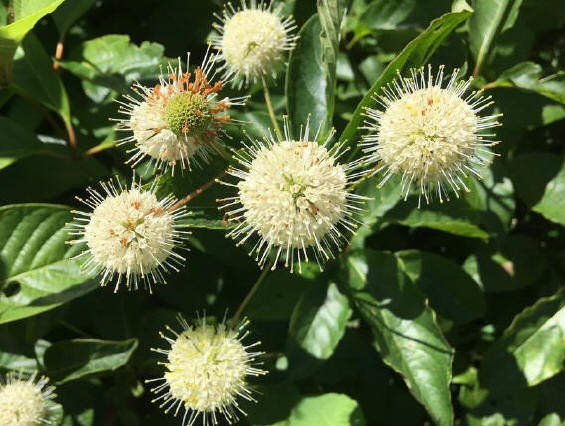Pam Haze
Adams County Master Gardener
(10/25) If you are looking for a shrub that can take poor draining or wet soil, consider planting a buttonbush. Buttonbush, known by its scientific name Cephalanthus occidentalis, is a hardy shrub that thrives in moist or wet soil and is relatively free of insect predation and disease. It is fast growing, reaching a height of 8 to 10 feet and a width of similar size. It is attractive with smooth green leaves, and in mid-summer, will be covered with fragrant white flowers that attract hummingbirds, bees, butterflies, and moths. In the winter the twisted trunks, dense and twiggy branches, and brown seeds are attractive features in the garden.

Buttonbush is native to the eastern United States and has a large range extending from Ontario to Florida. It is cold tolerant in zones 5 through 11 (we are in zone 6). It favors full sun although it will tolerate some shade. It prefers a soil pH that is neutral to slightly acidic, but it will tolerate a range of soil types including significant clay. It will not tolerate dry soil so it is best used in areas with wet conditions such as riparian areas, swamps, wetlands, and rain gardens. Buttonbush can tolerate flooding events and survive even when submerged in up to 3 feet of water.
Buttonbush has ornamental value, because of its form and remarkable flowers with a honey-like fragrance. The shrub grows from multiple stems that may twist as they mature into interesting shapes. The bark is dark gray and slightly peeling. The shrub can serve as a screen for privacy because of the density and fullness of the stems and leaves. The shiny green elliptical-to-ovate shaped leaves are arranged in an opposite or whorled manner along the stem. Buttonbush is deciduous so the leaves will drop off in the fall. The fall color is yellow to golden.
When it is in flower, July through August, the shrub will be covered with fragrant flowers that resemble a satellite, starburst, or pin cushion. Each golf-ball sized sphere is comprised of many tubular flowers packed tightly together, arranged in small clusters at the ends of the branches. The flowers will attract an array of pollinators including native bees, butterflies, and hummingbirds. The shrub is a host plant for 25 different types of moths (the larvae feed on the leaves) including two native sphinx or hawk moths.
The fruit of the shrub take the form of knobby green balls on long stems that turn brown as they mature. The fruits persist over winter and the seeds are a source of food for over 25 different types of waterfowl including woods ducks. Buttonbush is moderately deer resistant.
Buttonbush is toxic to humans, livestock, and domesticated animals. Native Americans used the bark and roots of buttonbush (in small doses) to treat a variety of maladies including sore eyes, diarrhea, rheumatism, skin irritations, headache, fever, venereal disease, toothaches, muscle inflammation, and blood disorders.
Maintenance requirements for buttonbush are minimal. Although it can be cut back to size in late winter/early spring, it does not need regular pruning. The dense growth of stems and leaves makes the bush an inviting place for songbirds to nest. Buttonbush is a good alternative to butterfly bush (Vitex) because of the similarity of growth habit and ability to attract and feed pollinators.
Buttonbush can be easily propagated from stem cuttings and from seed. Start stem cuttings in the spring when new growth appears. Unrooted cuttings can be pushed into moist soil and will establish on their own. Seeds can be collected in the fall and started in pots or by directly sowing in moist soil in the spring after the threat of frost has passed.
The shrub was introduced commercially in 1735 and grown as a source of nectar for honeybee honey production. Today, buttonbush is recognized for its ability to naturalize in wet areas and is used extensively to restore wetland habitat, control erosion in riparian areas and along shorelines, and to create habitat for wildlife and pollinators.
A variety of cultivars are available, including several that offer a more compact growth form as well as more vibrant fall leaf colors. Among them are:
- Sputnik, Cephalanthus occidentalis ‘Bieberich’, grows 8-10 feet high with a rounded habit;
- Sugar shack, C. occidentalis ‘SMCOSS’, is a more compact form that will grow 4-5 feet tall with red fruit instead of brown;
- First Editions Fiber Optics, C. occidentalis ‘Bailoptics’, is a compact form that will grow 6 feet tall;
- Magical Moonlight, C. occidentalis ‘Kolmoon’, is a compact form that will grow up to 4 feet tall and 4-5 feet wide;
- Ping Pong, C. occidentalis ‘J.N.Select A’, will grow 8 feet tall and wide with dark green, glossy leaves; and
- Crimson Comet, C. occidentalis ‘SMCBM’, is a compact form that will grow 6-10 feet tall and wide and has fall color in the reddish-orange range.
- Keystone, C. occidentalis ‘Keystone’, is a cultivar released by the U.S. Natural Resources Conservation Service in partnership with the Pennsylvania Game Commission, that was bred for wetland restoration. It grows up to 12 feet tall and to a width of 8 feet.
Read other articles by Pam Haze
Read other articles on ecological gardening & native plants